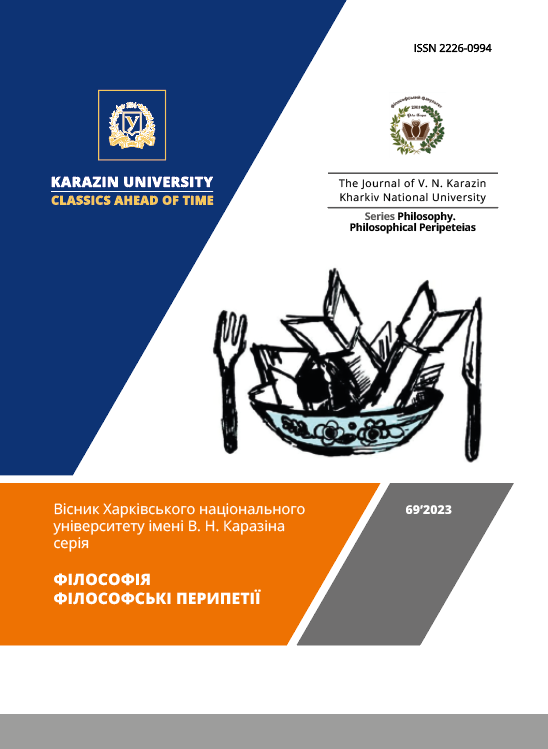VISUAL AND DIGITAL RHETORIC: THE EXPERIENCE OF COMPREHENSION
Abstract
Research on rhetoric is often limited to the history of the question and the analysis of rhetorical techniques from the classical rhetorical canon. However, in the modern world, this is not enough. This article is devoted to the study of questions about visual and digital rhetoric: your interrelated areas that play a key role in the modern information world, because with the help of rhetoric, various models of reality are tested, mastered and constructed. Because rhetoric by its very nature acts as a mechanism for constructing and interpreting models of reality, performing a key role in the formation of public consciousness. Within the framework of this abstract, we will consider the main aspects of the study of these disciplines, as well as their impact on the formation and perception of messages in modern society. Due to the rapid development of technology and constant changes in the media environment, philosophical analysis of visual and digital rhetoric is becoming a necessary tool for understanding the essence of new challenges. Visual rhetoric can create specific frames of perception, controlling the audience's attention and influencing their interpretation of events and phenomena. Digital rhetoric studies the impact of digital technologies on communication methods, language use, and the effectiveness of persuasion in a digital environment. Philosophical analysis of these areas becomes particularly important in light of the rapid development of technology and dynamic changes in the media environment, and therefore in the human consciousness. The philosophy-based approach allows for a deeper understanding of the nature and differences between visual and digital rhetoric, their roots, and ethical aspects. The philosophical approach allows us to ask solid, fruitful questions about how visual and digital media influence our beliefs, values, and cultural norms. Philosophy manifests the potential challenges and risks associated with the use of visual and digital means of communication, as digital rhetoric faces a number of challenges, such as excessive amounts of information, ephemeral messages, awareness of falsehood-authenticity, technical limitations, and others. The article justifies the importance of philosophical analysis in the context of the modern information landscape, helping us to interact more consciously and effectively with these powerful means of communication and expression. The article provides a framework for critical thinking that allows society to adapt to constant changes and develop in conditions of information saturation.
Downloads
References
Albrecht-Crane, Christa. (2015). Understanding Rhetoric: A Graphic Guide to Writing by Elizabeth Losh et al. (review). Rocky Mountain Review of Language and Literature, 69, 104–107.
Allen, Nancy. (1996). Ethics and Visual Rhetorics: Seeing's Not Believing Anymore. Technical Communication Quarterly, 5, 87–105.
Barthes, R. (1964). Le Degré zéro de l’écriture, suivi de Éléments de Sémiologie. Paris.
Baudrillard, J. (1981). Simulacres et simulation. Paris: Galilée.
Blair, J. A. (2004). The rhetoric of visual arguments. Defining visual rhetorics. Mahwah, N.J.: Lawrence Erlbaum Associates, pp. 41–61.
Boyle, Casey. (2018). The Digital: Rhetoric Behind and Beyond the Screen / Boyle Casey, Brown James J., Ceraso Steph. Rhetoric Society Quarterly, 48, 251–259.
Collins, D. (1992). Anamorphosis and the Eccentric Observer (parts 1 and 2). Leonardo, 25, 1, 2.
Douglas, Ch. (1989). Behind the Suprematist Mirror. Art in America, Sept, 164–176.
Eco, U. (1984). Semiotics and the philosophy of language. London.
Eliade, M. (1963). Aspects du myth. Paris: Gallimard.
Flaker, A. (1982). Poetika osporavanja. Zagreb.
Eyman, D. (2015). Digital Rhetoric: Theory, Method, Practice. San Francisco: University of Michigan Press. doi:10.3998/dh.13030181.0001.001.
Foss, Sonja K. (2004). "Framing the Study of Visual Rhetoric: Toward a Transformation of Rhetorical Theory". Defining Visual Rhetorics. New Jersey: Routledge, pp. 303-313.
Handa, Carolyn. (2004). Visual Rhetoric in a Digital World. New York: Bedford/St. Martin's.
Hocks, Mary E. (2003). Understanding Visual Rhetoric in Digital Writing Environments. College Composition and Communication, 54, 629–656.
Hodgson J., Barnett S. (2016). Introduction: What is Rhetorical about Digital Rhetoric? Perspectives and Definitions of Digital Rhetoric. Enculturation, November, 22. URL: https://enculturation.net/what-is-rhetorical-about-digital-rhetoric.
McComiskey, Bruce. (2014). Visual Rhetoric and the New Public Discourse. JAC: A Journal of Rhetoric, Culture, & Politics, 24, 187–206.
Miller, S. (2010). Constantin Brâncuș. London: Reaktion.
Mortensen, M., Allan, S., Peters, Ch. (2017). The Iconic Image in a Digital Age: Editorial Mediations over the Alan Kurdi Photographs. Nordicom Review, 38, Special Issue 2, 71-86. doi:10.1515/nor-2017-0415
Phillips, Barbara J., McQuarrie, Edward F. (2004). Beyond Visual Metaphor: A New Typology of Visual Rhetoric in Advertising. Marketing Theory, 4, 113–136.
Sarapik, V. (1999). The problem of titles in painting. Sign Systems Studies, 27, 148-167. https://doi.org/10.12697/SSS.1999.27.08
Sonesson, G. (1995). The Mute Narratives. New Issues in the Study of Pictorial Texts. Interart Poetics. Acts of the congress “Interart Studies: New Perspectives”, Lund, May. Lagerroth, Ulla-Britta, Lund, Hans, & Hedling, Erik, (eds.). Rodophi, Amsterdam & Atlanta 1997; 243–252.
Vizualnost. Zagrebački pojmovnik kulture 20. stoljeća (1995). Ured. A. Flaker, J. Užarević. Zagreb: Filozofski fakultet.
Zappen, J. P. (2005). Digital Rhetoric: Toward an Integrated Theory. Technical Communication Quarterly, 14, 3. URL: https://www.tandfonline.com/doi/abs/10.1207/s15427625tcq1403_10.
Copyright (c) 2023 Наталія Попова, Владислав Галстян, Ярослав Галстян

This work is licensed under a Creative Commons Attribution 4.0 International License.
Authors who publish with this journal agree to the following terms:
- Authors retain copyright and grant the journal right of first publication of this work under the terms of a license Creative Commons Attribution License 4.0 International (CC BY 4.0).
- Authors are able to enter into separate, additional contractual arrangements for the non-exclusive distribution of the journal's published version of the work (e.g., post it to an institutional repository or publish it in a book), with an acknowledgement of its initial publication in this journal.
- Authors are permitted and encouraged to post their work online (e.g., in institutional repositories or on their website) prior to and during the submission process, as it can lead to productive exchanges, as well as earlier and greater citation of published work.






3.gif)




